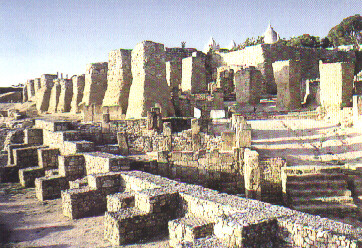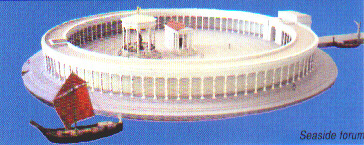|
||

Carthage is delenda. And they really did,- destroy Carthage. It is hard to imagine that this place housed the most beautiful and the richest sea port of ancient times, lasting for centuries until the destruction by the Romans in 146 BC. Carthage was destroyed simply because this capital had a tendency of surviving anything, and as it almost changed world history in the century before, Rome could not rest until three years of destruction, ending in 17 days of conflagration, had wiped Carthage out.
richest sea port of ancient times, lasting for centuries until the destruction by the Romans in 146 BC. Carthage was destroyed simply because this capital had a tendency of surviving anything, and as it almost changed world history in the century before, Rome could not rest until three years of destruction, ending in 17 days of conflagration, had wiped Carthage out.
 Even after the destruction of Carthage, the city returned to much of its old
splendor, but this was first under Roman rule, later it was after the decline of Rome. Actually Carthage survived Rome, and its era stretched over almost twice as many centuries as Rome did. Trying to discover what Carthage, is difficult. Even if the "total destruction" left some of the structures of Carthage in good shape, the need for building material removed both ancient Carthage and the younger Roman structures.
Even after the destruction of Carthage, the city returned to much of its old
splendor, but this was first under Roman rule, later it was after the decline of Rome. Actually Carthage survived Rome, and its era stretched over almost twice as many centuries as Rome did. Trying to discover what Carthage, is difficult. Even if the "total destruction" left some of the structures of Carthage in good shape, the need for building material removed both ancient Carthage and the younger Roman structures.

 The Punic port is the best place to visit, as Carthage so much was a sea port, dominating even the Roman empire for ages. The Punic port is very much
molded by man, and is a 100 meter wide canal shaped like a perfect circle. The inner part, 130
meters in diameter was both the quay, and the dock where repairs were done. In this small structure, gave room for as much as 220 slim ships. In the quay, little remains, a couple of rocks, telling you nothing, but one or two places, clear traces of the docks can be seen. This gives a clear indication of the size of the ships.
The Punic port is the best place to visit, as Carthage so much was a sea port, dominating even the Roman empire for ages. The Punic port is very much
molded by man, and is a 100 meter wide canal shaped like a perfect circle. The inner part, 130
meters in diameter was both the quay, and the dock where repairs were done. In this small structure, gave room for as much as 220 slim ships. In the quay, little remains, a couple of rocks, telling you nothing, but one or two places, clear traces of the docks can be seen. This gives a clear indication of the size of the ships.

What could have been the greatest
Carthaginian site, has been left
 without any funds from the Tunisian governments: The child sacrifice ground, called
without any funds from the Tunisian governments: The child sacrifice ground, called
Tophet, lying just 300
meters south of the Punic port. It is easy to understand, with the strong claim on early
civilization that Tunisia has, an exhibition of contemporaneous Barbary will dilute the image. Even if child sacrifice was only performed in times of extraordinary hardship. Anyway, there is an entry fee, but you see just as much from the outside.
![]() About a kilometer walk north of the Punic ports, the Byrsa quarter offers the third ground of any significance for most
travelers. This is the place that has the largest percentage of surviving Carthaginian
settlement, and what has been recovered is on display in the museum that has been put up here.
About a kilometer walk north of the Punic ports, the Byrsa quarter offers the third ground of any significance for most
travelers. This is the place that has the largest percentage of surviving Carthaginian
settlement, and what has been recovered is on display in the museum that has been put up here.

![]()